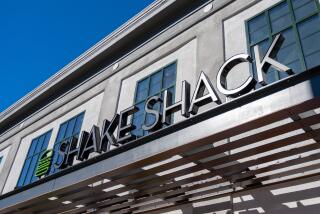McDonald’s profit rises but leaves Wall Street with hunger pangs
McDonald’s Corp. has mustered up healthful new food options, sparkling restaurant remodels and targeted marketing efforts. But satisfactory sales are still off the menu.
The world’s largest burger chain reported a 4% boost to $1.4 billion in second-quarter profit that missed Wall Street’s forecasts. Same-store sales at U.S. restaurants open more than a year were down in June. Globally, McDonald’s expects them to be flat in July.
And at the rate it’s going, the company’s results for the rest of 2013 “are expected to remain challenged,” Chief Executive Don Thompson said in a conference call with analysts Monday. He pointed to “ongoing global economic head winds,” including increasing competition, industrywide discounting measures and higher labor and commodity costs.
“While the informal eating-out market remains challenging and economic uncertainty is pressuring consumer spending, we’re continuing to differentiate the McDonald’s experience by uniting consumer insights, innovation and execution,” Thompson said.
The hamburger market is lagging behind both the overall restaurant industry and the quick-service segment, according to data from research firm NPD Group Inc. From June 2012 until May 2013, total traffic at eateries was flat compared with a year earlier while rising 1% among quick-service locations.
But burger joints suffered a 1% decline. Sales growth has also been slower, according to the data. Analysts blamed hesitant consumers still trying to adapt to payroll tax increases and high gas prices.
“Recently, it’s been a very difficult industrywide environment — it’s not just McDonald’s,” said Chuck Pinson-Rose, an analyst with Standard & Poor’s. “There’s been a deceleration from last year. The consumer is having a hard time.”
During the quarter, revenue at the Oak Brook, Ill., company rose to nearly $7.1 billion, up 2% and in line with analyst predictions. Global same-store sales got a 1% boost after dipping in the first quarter.
Net income of $1.4 billion, or $1.38 a share, was up from $1.35 billion, or $1.32 a share. Analysts surveyed by Thomson Reuters had expected earnings of $1.40 a share.
McDonald’s stock fell $2.69, or 2.7%, to $97.58 Monday. So far this year, it’s up 12.4%.
Over the same period, KFC and Taco Bell owner Yum Brands Inc. is ahead 9%, Burger King has risen 19.1%, Jack in the Box is up 40.6% and Wendy’s has surged 43.9%.
In its second quarter, McDonald’s same-store sales slid 0.1% in Europe and 0.3% in the Asia, Middle East and Africa division.
Many fast-food brands, which have spent the last decade flooding into China, have recently hit a wall in the country. Avian influenza and other food-safety scares have companies scrambling to shore up their inspection processes. Yum has encountered wage inflation and rising rents, said John A. Gordon, principal with Pacific Management Consulting Group.
But as major chains move into less-expensive areas, they’re finding less social acceptance of quick-service dining, Gordon said.
“The further out you go from the urbanized core, the less natural propensity there is to eat at restaurants,” he said.
McDonald’s had better luck in the U.S., where same-store sales increased 1% during the quarter. The uptick included a 2.6% surge in May, the first positive figure in months.
The chain is attempting to match changing consumer tastes by adapting its famously fatty meals to a more calorie-conscious mind-set. During the second quarter, more healthful options such as Chicken McWraps and Egg White Delight sandwiches hit menus.
“There’s no question that McDonald’s is still the 800-pound gorilla out there,” said Conrad Lyon, an analyst with B. Riley & Co.
But these days, the chain is sitting uneasily on its fast-food throne.
During the recession and in its immediate aftermath, analysts saw fast-casual chains such as Smashburger and Five Guys Burgers & Fries as the main threat to McDonald’s, with their fresher, fuller burgers. But direct fast-food competitors such as Carl’s Jr. and Jack in the Box are now doubling their efforts, attempting to draw consumers still struggling with low personal spending power, analysts said.
“McDonald’s had some momentum taken away by Burger King once they got their act together and rolled out new menu items,” Gordon said.
A number of other competitors are also rolling out unique items that are siphoning fast-food market share from McDonald’s.
This summer, Wendy’s launched a Pretzel Bacon Cheeseburger around the same time Jack in the Box unveiled its Big Waffle Stack, featuring eggs, cheese, bacon and other meats between two maple waffles. Earlier, Dunkin’ Donuts unleashed its Glazed Donut Breakfast Sandwich, with eggs and bacon between doughnut halves. Taco Bell calls the Doritos Locos Taco, which launched last year, the most successful product launch in its history.
“At the end of the day, it’s just getting harder to innovate, coming up with that one higher-priced item that people go gaga over and have to go to your store to get,” Lyon said. “You just haven’t seen that out of McDonald’s for a long time.”
And smaller, more nimble rivals are increasingly offering a core national menu with regional variations to appeal to different preferences, Gordon said.
“McDonald’s is almost so big and broad now that they’re trying to get a vanilla menu to work in all parts of the country,” he said. “As the country becomes more diverse, it’s harder to get Santa Monica tastes to work the same way as they do in Kentucky.”
Twitter: @tiffhsulatimes
More to Read
Inside the business of entertainment
The Wide Shot brings you news, analysis and insights on everything from streaming wars to production — and what it all means for the future.
You may occasionally receive promotional content from the Los Angeles Times.











